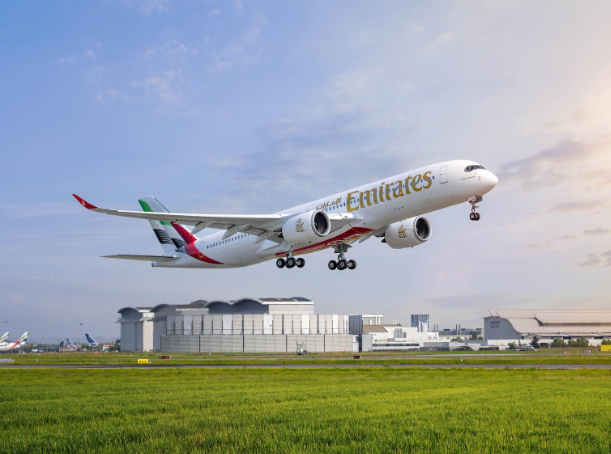Emirates, the world’s largest long-haul airline, is set to receive its first Airbus A350-900 aircraft in the first week of December after facing multiple delays this year.
The airline’s first commercial flight for this model will now be to Edinburgh, scheduled for mid-January, according to Adnan Kazim, deputy president and chief commercial officer of Emirates.
He shared this update during the Arab Air Carriers Organisation meeting in Jordan. Following Edinburgh, the A350 will serve regional routes to Ahmedabad, Mumbai, Colombo, Muscat, Kuwait, and Bahrain.
Emirates aims to take delivery of eight A350s by the end of its financial year, which runs from April 1 to March 31. The initial delays were caused by supply chain issues affecting parts like seats and inflight entertainment, along with technical testing both on the ground and in the air.
The airline has ordered 65 Airbus A350-900 planes. The first deliveries were originally expected in August but were postponed to October and then again to November.
Emirates plans to receive eight A350s by the end of its financial year, which runs from April 1 to March 31.
Additionally, the airline is facing significant delays from both Boeing and Airbus, combined with declining production quality from suppliers, impacting its expansion plans, Mr. Kazim noted.
“We’re not here to blame anyone, but the industry has gone through major changes where many skilled workers left for other industries during COVID,” he said. “We lost a lot of experienced professionals across the supply chain and manufacturers, with decades of knowledge and skills.”
Mr. Kazim explained that recovering from this loss takes time, and it’s uncertain if those skills will return.
Quality issues have caused further delays, as Emirates refuses to accept products that don’t meet its high standards. “We are firm about our requirements, and part of the delays is to ensure that the aircraft flying with us meet those standards. We won’t compromise,” he said.
“We could have accepted some of these aircraft and worked on them later, but that’s not how Emirates operates. It’s a challenging situation. Quality is one issue, but production delays are another.”
These issues have hindered Emirates’ growth, forcing the airline to delay its planned expansion while incurring high costs to retrofit existing aircraft to keep them in service longer.
For example, Emirates was expected to receive 80 Boeing 777X planes, but their introduction has now been delayed until the second half of 2026.
The airline’s legal team is actively negotiating with Boeing for compensation due to these delivery delays, but Mr. Kazim mentioned that the compensation is “only a small fraction” of the impact from not having the aircraft available.
“We can’t predict a timeline for the 777X delivery, even though we expect it in the second half of 2026. It’s hard to say how things will develop,” he stated.
In October, Boeing announced another delay for the 777X’s entry into service until 2026 due to certification problems. Deliveries were first scheduled for 2020, with Emirates having ordered 205 of these jets, making up nearly half of the total backlog.
“We will pursue compensation, but that’s not our main goal. Our priority is getting the aircraft in the air, as many plans depend on them,” Mr. Kazim said.
Currently, Emirates operates flights to 147 destinations worldwide, aiming to expand to over 170 by 2030.
“There’s rising demand from different regions, especially in Asia. We’re also seeing growth from Africa and the US, and these aircraft would enable more expansion,” Mr. Kazim noted.
Emirates, which typically releases its first-half financial results in November, has seen “very strong” demand in the first six months of its fiscal year. Many routes have achieved load factors above 90 percent, particularly in premium cabins for first and business class.
So far, Emirates has recovered about 95 percent of its pre-COVID network size, resuming flights to cities like Adelaide and Lagos while adding new routes to places like Bogota.
About 60 percent of its route network will soon feature the premium economy cabin, reaching 42 destinations by the end of the financial year, up from 24 now. Approximately 63 aircraft will include the premium economy cabin by the end of March, increasing from the current 38.









